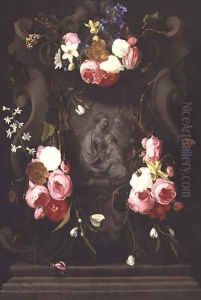& Quellinus, E. Seghers, D. Paintings
Erasmus Quellinus II, born in 1607 in Antwerp, was a prominent Flemish Baroque painter and draughtsman who played a significant role in the artistic scene of the 17th century. His family was well-entrenched in the arts; his father, Erasmus Quellinus I, was a sculptor, and his brother, Artus Quellinus the Elder, became a famous sculptor. Erasmus II initially trained with his father and later became a student and collaborator of Peter Paul Rubens, one of the most influential artists of his time. This association significantly shaped Quellinus's style, which combined Rubens's dynamic compositions with his own attention to detail and love of classical themes.
After Rubens's death in 1640, Quellinus emerged as one of the leading painters in Antwerp, receiving commissions for altarpieces, portraits, and history paintings. He was particularly noted for his skill in depicting textures and surfaces, a talent that made his mythological and religious scenes resonate with viewers. Quellinus's works often reflected the intellectual and cultural interests of his patrons, who included members of the Antwerp city government, religious institutions, and the nobility across Europe. In addition to his painting, Quellinus was also a gifted draughtsman and etcher, contributing to the spread of the Baroque style throughout the continent.
His marriage to Catharina de Hemelaer in 1639 linked him further with the artistic community, as his wife was related to Jan-Baptist de Vos the Elder, another painter. Quellinus's workshop became a training ground for the next generation of artists, including his own children. Despite the high demand for his works and his success, little is known about his personal life beyond his achievements in the art world. Erasmus Quellinus II died in 1678, leaving behind a legacy that continued to influence Flemish art, bridging the gap between the exuberance of Rubens and the more classical approach that would characterize later Baroque and early Rococo periods.
